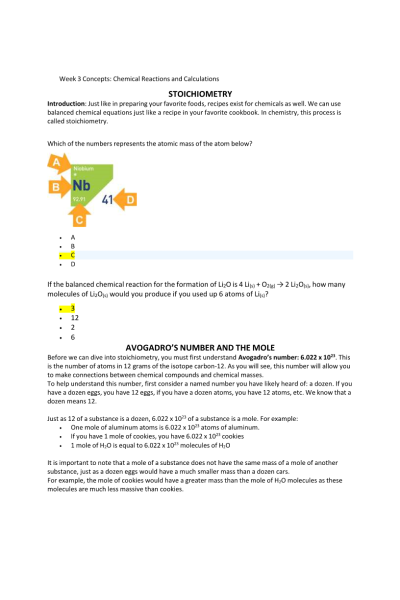CHEM 120 Week 3 Concepts; Chemical Reactions and Calculations
-
$25.00
| Institution | Chamberlain |
| Contributor | Karin Austin |
Document Preview
STOICHIOMETRY
Introduction: Just like in preparing your favorite foods, recipes exist for chemicals as well. We can use balanced chemical equations just like a recipe in your favorite cookbook. In chemistry, this process is called stoichiometry.
Which of the numbers represents the atomic mass of the atom below?
- A
- B
- C
- D
If the balanced chemical reaction for the formation of Li2O is 4 Li(s) + O2(g) → 2 Li2O(s), how many molecules of Li2O(s) would you produce if you used up 6 atoms of Li(s)?
•
- 12
- 2
- 6
AVOGADRO’S NUMBER AND THE MOLE
Before we can dive into stoichiometry, you must first understand Avogadro’s number: 6.022 x 1023. This is the number of atoms in 12 grams of the isotope carbon-12. As you will see, this number will allow you to make connections between chemical compounds and chemical masses.
To help understand this number, first consider a named number you have likely heard of: a dozen. If you have a dozen eggs, you have 12 eggs, if you have a dozen atoms, you have 12 atoms, etc. We know that a dozen means 12.
Just as 12 of a substance is a dozen, 6.022 x 1023 of a substance is a mole. For example:
- One mole of aluminum atoms is 6.022 x 1023 atoms of aluminum.
- If you have 1 mole of cookies, you have 6.022 x 1023 cookies
- 1 mole of H2O is equal to 6.022 x 1023 molecules of H2O
It is important to note that a mole of a substance does not have the same mass of a mole of another substance, just as a dozen eggs would have a much smaller mass than a dozen cars.
For example, the mole of cookies would have a greater mass than the mole of H2O molecules as these molecules are much less massive than cookies……….. Continue
| Instituition / Term | |
| Term | Summer |
| Institution | Chamberlain |
| Contributor | Karin Austin |





-80x80.JPG)



-80x80.JPG)





























































